Collection

Gordon Matta-Clark
Office baroque (Ufficio barocco)
1978
Stampa cibachrome a colori in cornice originale d’artista
120 x 80 cm
Figura centrale della scena artistica americana degli anni Settanta, Gordon Matta-Clark (1943-1978) fu pioniere di un approccio radicale all’arte, che coinvolgeva il contesto urbano e le sue comunità. La sua pratica annullava i confini tra arte, vita privata e pubblica. Fondatore del ristorante Food a Soho, che diventò luogo di incontro e scambio della comunità artistica newyorkese, dopo aver studiato architettura diede vita a un collettivo chiamato Anarchitecture. Il suo approccio all’architettura era, come suggerisce il nome del gruppo, anarchico e critico verso il sistema, mirando a mettere in luce le contraddizioni socio-economiche alla base dello sviluppo urbano.
La sua intensa carriera artistica si situa tra il 1971 e l’anno della prematura scomparsa, avvenuta nel 1978. In questo breve lasso di tempo, Matta-Clark interviene su edifici dismessi operando tagli, realizzando buchi oppure eliminando muri o altri elementi architettonici. Queste investigazioni, che in alcuni casi assumono proporzioni monumentali, vengono condotte su edifici destinati a essere distrutti, che l’azione dell’artista trasforma in commenti riguardanti l’inevitabile temporalità dell’architettura e il sovvertimento dei suoi principi basilari. L’edificio manipolato diventa il luogo di visioni prospettiche inedite, attraverso l’apertura di brecce nella propria struttura o la segmentazione di spazi normalmente preclusi allo sguardo umano. Questi interventi vengono documentati dall’artista con fotografie, film e video, che egli realizza come opere d’arte indipendenti e che, insieme ai frammenti prelevati da alcuni edifici, rimangono i suoi unici lavori oggi visibili.
Office Baroque consiste in una serie di tagli e asportazioni di parti di un edificio di uffici ad Anversa, alto cinque piani; esso fu il penultimo progetto architettonico realizzato dall’artista prima della sua morte. Ispirato dalla sovrapposizione delle tracce circolari lasciate da tazze da tè su un disegno, l’intaglio realizzato nell’architettura prendeva forma da due semicerchi arcuati ritmicamente attraverso i piani, andando a formare con la loro intersezione una forma che ricorda una barca a remi. Matta-Clark descrisse l’opera come “una passeggiata attraverso un arabesco panoramico”. Come in tutti i suoi interventi, l’edificio stesso costituiva l’opera d’arte. Per contrastare la natura effimera dei suoi gesti scultorei, Matta-Clark affidò la loro documentazione a una serie di fotografie uniche, realizzate sovrapponendo e montando i negativi, andando a creare immagini che ricordano le sovrapposizioni spaziali cubiste. Anche queste furono trattate dall’artista come immagini uniche e irripetibili, frutto di uno sguardo che registra, crea e trasforma allo stesso tempo spazi, oggetti e loro rappresentazioni.
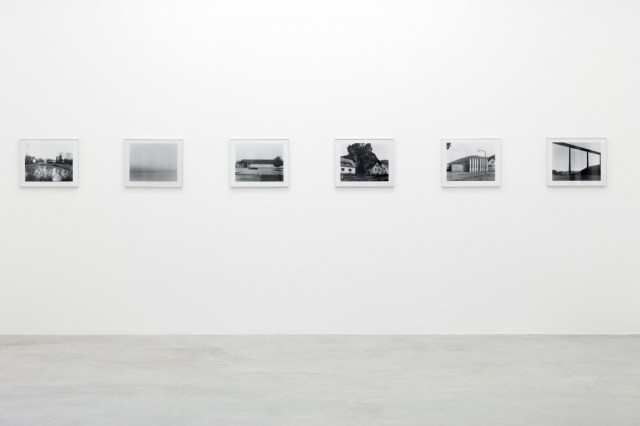
Michael Schmidt
Irgendwo (Somewhere)
2001-2004
Gelatine silver print
40,5 x 50 cm
Born and raised in Berlin, Michael Schmidt (1945-2014) holds a unique stead in the history of contemporary German photography together with fellow members of the so-called Düsseldorf School, including Andreas Gursky, Thomas Ruff and Thomas Struth. He attracted worldwide attention as a self-taught photographer. He bought his first 35mm camera in 1965 upon the suggestion of a colleague at the Berlin Police Department. Schmidt left the institution in 1972, built himself a darkroom at home and began teaching photography classes while perfecting his own technique. Only one year later, he published the first of the eventual twenty-two books he authored.
Realised between 2001 and 2004, the Irgendwo series consists of 71 gelatin silver prints. The meticulously composed black-and-white photographs, characterised by a rich gamut of grays, were taken over the course of Schmidt’s extensive three-year travels across Germany. Somewhere brings together grim snapshots of provincial life in Germany: suburbia, village pubs, deserted discounters, historic buildings, landscapes rifted by far-away motorways. As is typical of his practice, Schmidt combines photographs of the architecture and the landscape with portraits and shots of seemingly irrelevant details. It is only by way of grouping and interaction that the individual images acquire meaning while relations emerge between geography and autobiography. As the title of the series itself suggests, the photographs do not depict any specific place, but rather speak of Schmidt’s own desire to capture the rarefaction of all objective connections between the home and the construction of identity: “The term ‘home’ does not mean anything to me. In all instances, home is what you carry with you, inside you. You remember places because you spent the most beautiful or the most horrible time of your childhood there. But these places have become more arbitrary, less specific…. There is no longer an objective category that you can call ‘home’. These days these things happen subjectively.”
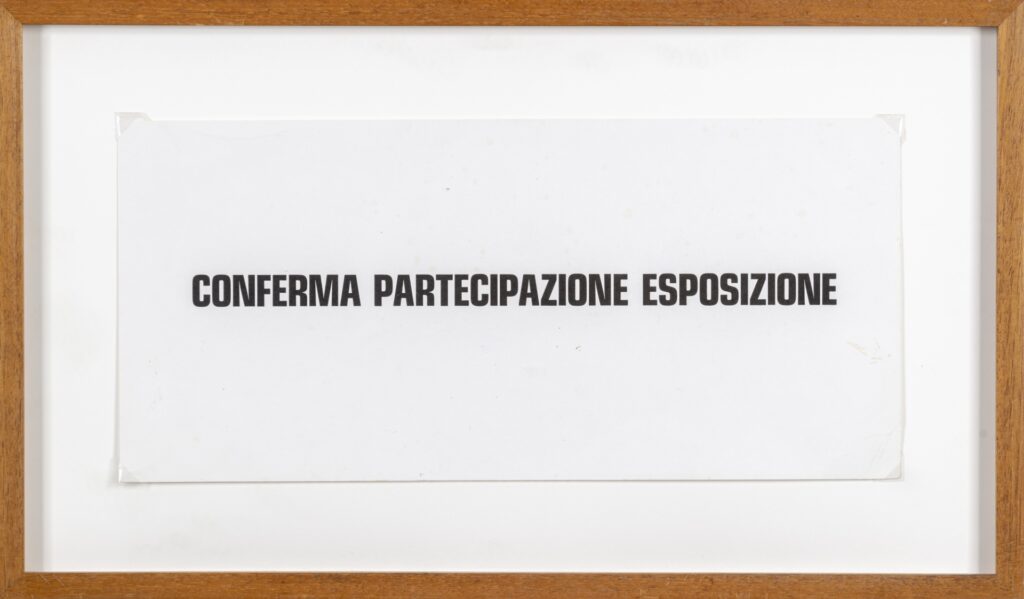
Emilio Prini
Conferma partecipazione esposizione (nato vecchio) (Exhibition Participation Confirmation (born old))
1970
Print on paper
25 x 50 cm
Born in Stresa in 1943, Emilio Prini has taken part in many exhibitions of the Arte Povera group since the Sixties. His oeuvre bears political and conceptual implications that reify in the objecthood of his works: manifestos, statements, programmatic declarations, simple exhibition invitations. After showing at numerous international exhibitions until the 1970s, he progressively disappeared from the art scene. His immaterial and enigmatic practice contributed to the consolidation of an auratic myth around his figure. Prini died in Rome in 2016.
Following his participation in key conceptual art and Arte Povera exhibitions, including Harald Szeemann’s When Attitudes Become Form held at the Bern Kunsthalle in 1969 and the tenth edition of Documenta in 1997, Prini showed less and less frequently. On some occasions, he limited himself to confirming his participation. To the Kunstmuseum of Lucerne’s 1970 exhibition Processi di pensiero visualizzati (lit. visualised thought processes), he sent a telegram stating: “I confirm exhibition participation”. Other times, Prini published his participation confirmation in the exhibition catalogues alone. This was the case, for instance, for the exhibition Pèrsona at the International Theatre Festival of Belgrade in 1971, when he wrote: “Confirmation of participation, edition – mail and telegraphs – public telephone – telephone Genoa Emilio Prini Achille Bonito Oliva 06326589 Rome”. Over time, Prini made his presence ever-thinner, so much so that he even disappeared from the pages of the catalogues devoted to him, as was the case for the Arte Povera exhibition held at the Kunstverein in Munich in 1971.
Robert Barry
Robert Barry was born in 1936 in New York. He currently lives and works in New Jersey. Along with Lawrence Weiner, Joseph Kosuth and Douglas Huebler, Barry belongs to the first generation of conceptual artists. From the mid-1960s, he probed the limits of materiality and visibility, questioning its presence in time and space. Reflecting on the dematerialization of the artwork as an object, Barry famously had the three galleries that were meant to host exhibitions of his work in 1969 announce their closure. In the former part of his career, he almost only relied on non-material supports like ultrasound, magnetism and telepathy while at later stages he resorted to more traditional techniques, including painting and photography. Well known are his installations centred around the written word for which Barry printed capital letters directly onto walls and other surfaces to intimate a narrative and inspire contemplation.
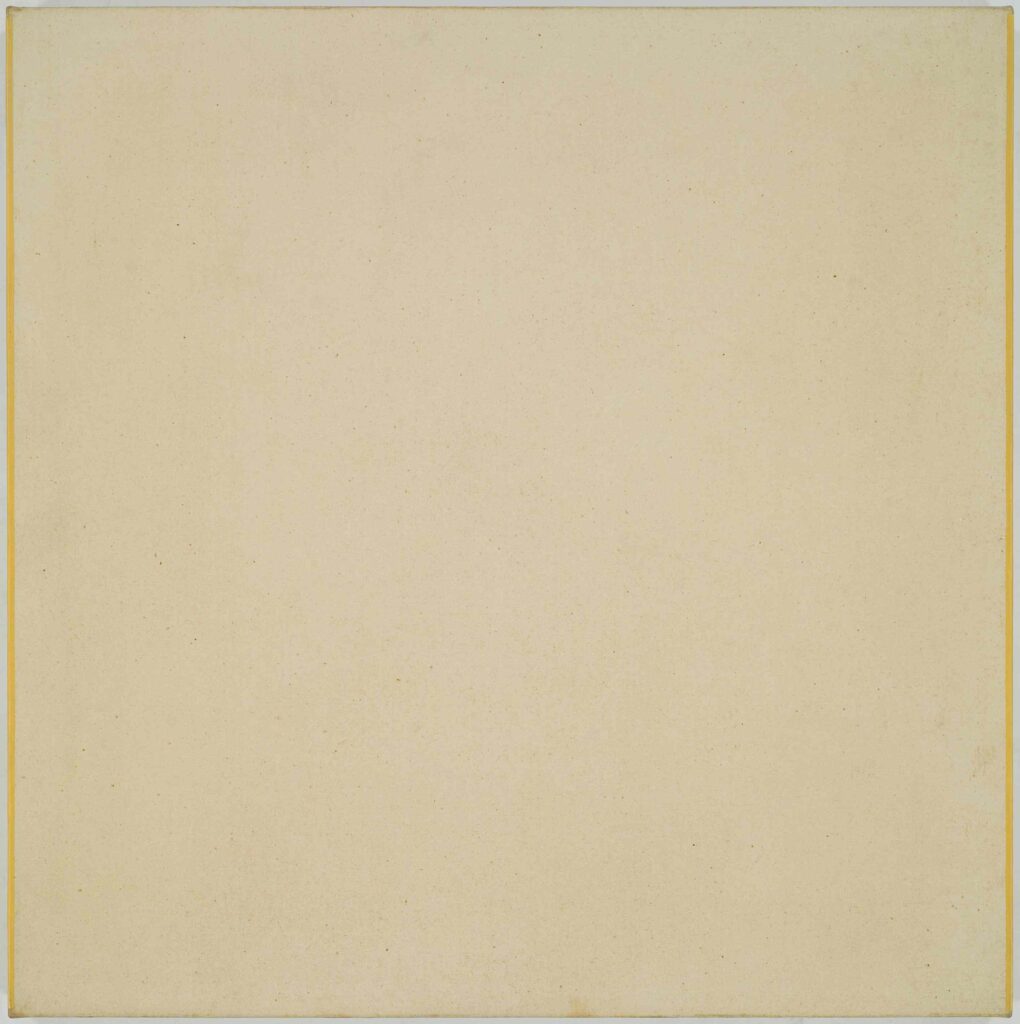
Untitled
1967
Acrylic on canvas
89 x 87,5 cm
After graduating in Art from Hunter College in New York in 1963, Barry began his career as a painter. Like most artists of his generation, he rejected the monumentality typically associated with Abstract Expressionism and Minimalism, as well as the traditional framing of the artwork as an object. Moving from these premises, Barry set out to take and tear painting apart. From the year 1967, he started producing scattered and fragmentary monochrome wall paintings that responded to the space wherein they were placed rather than acquiring meaning based on the content they framed. “It just dawned on me that the space around the painting was interesting”, said the artist.
From that moment on, Barry has investigated the relationships between surface, space and volume; positive and negative forms; presence and absence; the void and the viewer. This, with the aim to reduce the physical encumbrance of the art object to a minimum. In the work shown here, the artist purposely left the canvas raw and exposed. The two light ochre stripes around the outer vertical edges of the painting bridge between the work and its surroundings. The painting thus leaks out of the physical boundaries of the canvas and the frame, and leaps into the realm of the viewer.
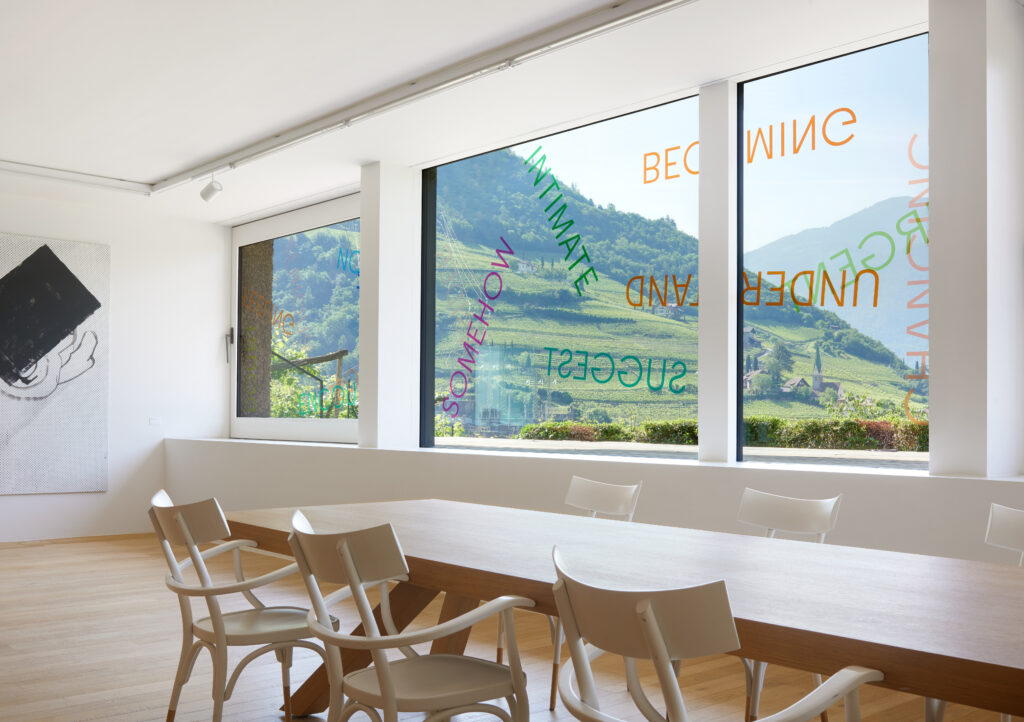
Beyond, Instead, Possible…
2012
Window decal
Dimensions variable
In the 1970s and even more so in the 1980s, the word became the primary token of expression in Barry’s practice, both in writing and as sound. Barry arranged single words in space as installations to induce a tension between their evocative power and the relationship they entertained with the surrounding architecture, even when they took up an autonomous three-dimensional and sculptural dimension. When Barry visited the Foundation in 2012, he conceived of a site-specific work for the library windows. Words are here stuck onto the glass with an adhesive material that breaks up the light coming into the room. A kaleidoscopic game of refractions touching and overlapping onto one another is triggered. The evocative power of the individual words is amplified so as to stimulate sense perception and the construction of sense as a whole. Physical space and mental space fuse into a continuum. Some words hint to that which cannot be determined like ‘unknown’, ‘somehow’, ‘another’ and ‘doubt’. Other words, instead, evoke an intimate and private dimension, including ‘intimate’, ‘feeling’, personal’. Others still convey a sense of surprise for the setting wherein one finds itself, including ‘glorious’ and ‘wonder’. The words as a whole give rise to a constellation of terms and meanings that establish bonds between individuality and collectivity, the exhibition space and the garden, thoughts and things.
The words around which Barry plays in his installations are drawn from a list of around two hundred different terms, each of which is especially chosen based on the site wherein it is destined to be exhibited.
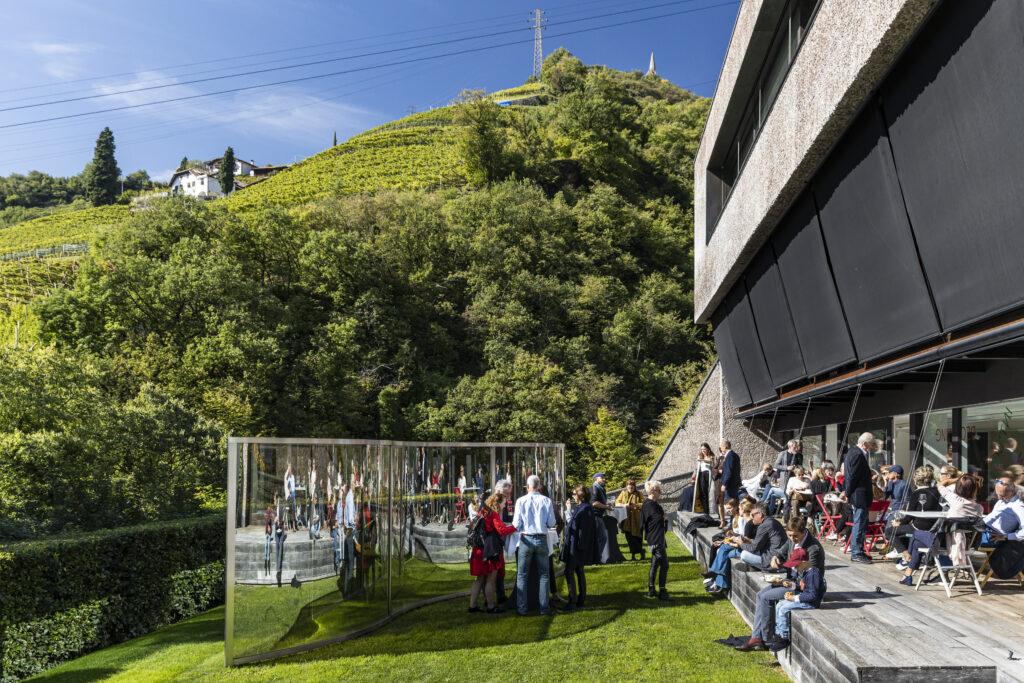
Dan Graham
Bolzano Pavilion
2008
Two-way mirror, stainless steel
Dan Graham was born in Urbana, Illinois, in 1942. He has been living and working in New York since 1963. He is regarded as one of today’s key conceptual artists and has been active as a critic, curator and artist since the Sixties. Operating across media, Graham produces videos, sculptures and installations. In 1964, he founded the John Daniels Gallery in New York, where he curated numerous exhibitions devoted to American minimalist artists, including Dan Flavin, Donald Judd, Sol LeWitt and Robert Smithson. From the end of the 1960s, he turned with increased frequency to video and performance, sharpening his focus on the theme of architecture as a relational and perceptive space. Graham’s recurring preoccupations are the concepts of time perception, memory and the body in space. Around these themes, he conceived of the so-called Pavilions, an ambitious installation series half-way between sculpture and architecture. Made of glass, iron and reflecting materials, these structures are installed in public spaces and are fully accessible to visitors.
In 2008, Graham designed the Bolzano Pavilion especially for the Fondazione Antonio Dalle Nogare. The characteristic two-way mirror typical of Graham’s works comes with a unique property: it is transparent on one side and reflecting on the other. The angles of the refractions are multiplied through the clever contrivance of the glass sheets, giving rise to overlapping images based on the movements and the mood of the people walking past. The brightness of the light and the changing outside landscape add to the waltz of mirroring reflections bringing the space to life.
Graham conceives of his pavilions as places of encounter, leisure, conversation, entertainment and recollection open to all. “My work is always about how viewers see themselves,” says Graham. The study of the relationship between art, architecture, the environment and the spectator is a recurring element in Graham’s rigorous conceptual research. Realised in the 1980s, his first pavilions emerged from the artist’s reflections on landscape architecture and the public function of gazebos and belvederes. In the essay Garden as Theater as Museum (1988), Graham interprets Renaissance gardens as the first museums in Western history. It was this book that convinced Graham to locate the Bolzano Pavilion in the Foundation’s garden, a crossroads between the surrounding vineyards and the Alpine landscape.

Olivier Mosset
Untitled
1966/1972
Acrylic on canvas
100 x 100 cm
Olivier Mosset was born in Bern, Switzerland, in 1944. He currently lives and works in Tucson, Arizona. Together with Daniel Buren, Michel Parmentier and Niele Toroni, he was the founder of the the Paris-based BMPT group in 1966. The four artists produced provocative happenings and minimalist works with the radical aim to slit the throat of painting. As such, Mosset came to be regarded as one of the fathers of minimalism. He is especially known for his large oil and acrylic canvases by means of which he explores the possibilities of conceptual abstraction. Large colored surfaces, circles, matter and the obsessive repetition of geometric patterns mark the stages of his uncompromising and dynamic work rebuffing all inklings of subjectivity.
Key to Mosset’s oeuvre are the Circle Paintings, a series of white canvases with a black circle in the centre, realised between 1966 and 1972. Shown at BMPT group exhibitions since 1967, Untitled belongs to those works that were nailed to their own frames, as opposed to later versions in which the canvas was folded and stapled. It is through early paintings like the one exhibited in this room that the Swiss artist gained international acclaim. Mosset produced about two hundred Circle Paintings, half of which were destroyed. The circles bear clear links to both Pop Art and Minimalism. In particular, there seem to be clear nods to Kenneth Noland’s targets – if only for the essential structures – and well as to Andy Warhol’s iterative patterns. Perfectly placed in the center of the canvas, the black circle draws the viewer in, preventing him from looking away. The obsessive repetition of one given element defining the Circle Paintings undermines the very concept of uniqueness in art. The artist lies behind each and every work, yet the single canvases are made to speak for themselves, to exist in themselves. The principle of authorship in painting is challenged bottom up.
Now running
13.04.2024 — 22.02.2025
Under the Spell of DuchampNow running
13.04.2024 — 28.12.2025
«May I Help You?» Andrea FraserUpcoming
25.09.2024
DADAUpcoming
23.09.2024
Bolzano Danza «PUSH»14.07 — 14.07.2024
International Museum Day 202419.05 — 19.05.2024
Andrea Fraser lecture & seminar22.04 — 23.04.2024
TIME. A performance by & with David Lamelas24.02 — 24.02.2024
THE DESERT PEOPLE by David Lamelas11.12 — 11.12.2023
WIDE WHITE SPACE. Une seconde d’eternité10.11 — 10.11.2023
Go to the full
programme
→